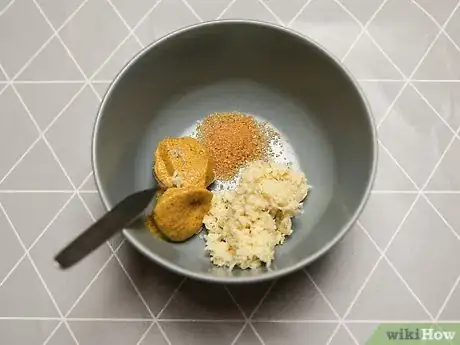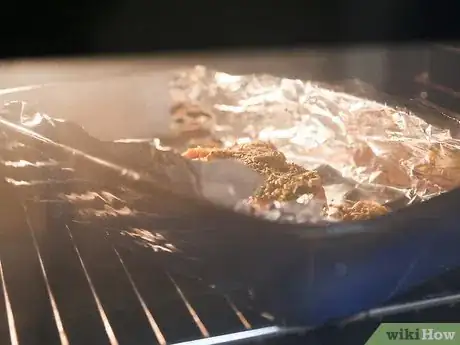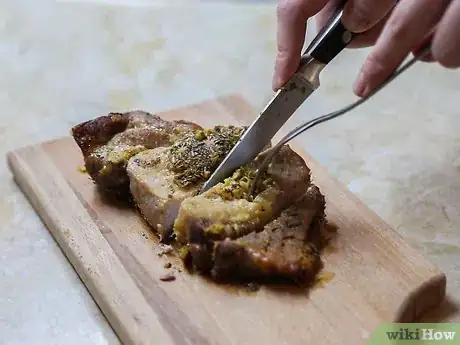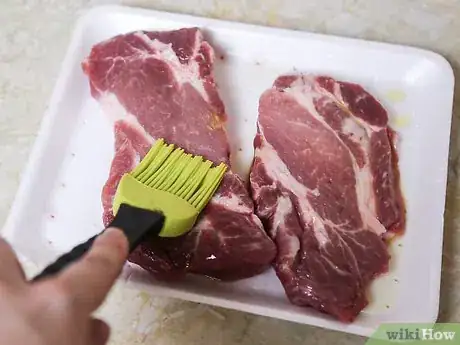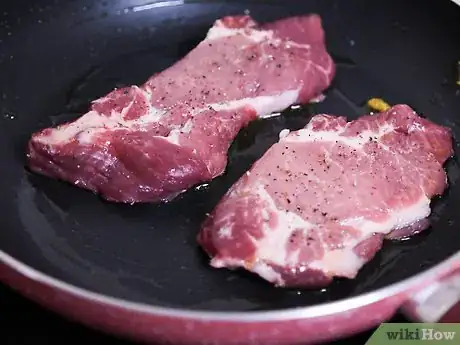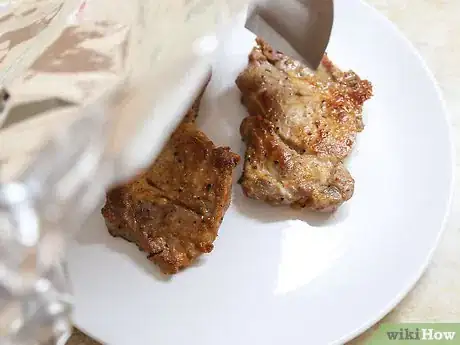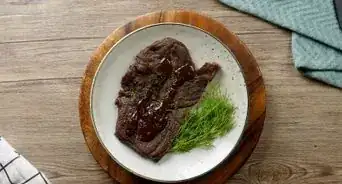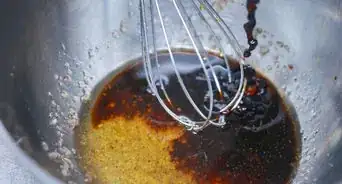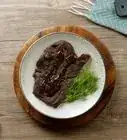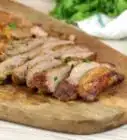This article was co-authored by wikiHow Staff. Our trained team of editors and researchers validate articles for accuracy and comprehensiveness. wikiHow's Content Management Team carefully monitors the work from our editorial staff to ensure that each article is backed by trusted research and meets our high quality standards.
This article has been viewed 49,997 times.
Learn more...
Scotch fillet is the name for ribeye steak in Australia, New Zealand, and South Africa. The meat for this type of fillet is taken from the main muscle attached to the cow's spine. You can cook scotch fillets very quickly and while there are a variety of methods you can use to cook a scotch fillet, the best 2 methods are to roast it or to fry it in a pan. You can serve your scotch fillet with fries or potatoes and vegetables for a delicious meal.
Ingredients
- 750 grams (26 oz) of beef scotch fillet
- 2 tsp (10ml) of horseradish cream
- 2 tsp (10ml) of mustard
- 2 tsp (10ml) of brown sugar
- 1 tbsp (15ml) of olive oil
- Parsley or tarragon
Makes 6 servings
- 4 scotch fillet steaks
- 1 tsp of sea salt flakes
- 2 tbsp of white vinegar]
- 1 tsp (5ml) of olive oil
- 2 eggs
- 150 grams (5.3 oz) of butter
Makes 4 servings
Steps
Making Roast Scotch Fillet
-
1Preheat your oven to 200 °C (392 °F). Make sure you don't preheat the oven to a higher temperature than 200 °C (392 °F) as the excess heat will cause the meat to shrink when it's in the oven. If you have a gas oven, put the dial to gas mark number 6 to heat to this temperature.[1]
- Electric ovens heat up faster than gas ovens so keep this in mind when you're deciding what time you want to start cooking.
-
2Line foil or baking paper on your baking tray. Cover the entire tray with foil or baking paper. Use foil if you want your fillet to have a crispier bottom when finished. Baking paper will ensure that the bottom is cooked as evenly as the rest of the fillet.[2]Advertisement
-
3Take your meat from the fridge 1 hour before cooking. Your beef fillet will cook a lot better if it's at room temperature when you put it in the oven. Cover the beef fillet with a dish or a tea towel if you want to keep it at a constant heat.[3]
- If you take the meat straight out of the fridge and put it into the oven, the fillet won't taste anywhere near as good as it should.
-
4Heat up a pan with 1 tbsp (15ml) of olive oil and add the fillet to the pan. Rotate the fillet to ensure the whole fillet is browned evenly when cooking. It should take about 4-6 minutes for the meat to turn brown. Don't let the oil get too hot as it will burn the fillet.[4]
-
5Mix the cream, mustard, and sugar and coat the meat with the mixture. Add 2 tsp of horseradish cream, 2 tsp of mustard, and 2 tsp of brown sugar to a bowl and mix using a fork or a whisk. When finished, drizzle the mixture over the fillet, trying to spread it as evenly as you can.[5]
-
6Place the beef on the baking tray and season with salt and pepper. Sprinkle your salt and pepper evenly over the beef and sprinkle some onto the foil or baking paper. Be careful to not use too much pepper as it can easily mask some of the flavor of the fillet.[6]
-
7Wrap your fillet with string and place herbs under the string. Place your string around your fillet at 5 centimetres (2.0 in) intervals. You can use a ruler if you'd like but rough estimates should be okay. Make sure the string is tight when you tie the knot. Then lift the string and place parsley or tarragon under the string, securing them in place.
- Don't use a plastic twine or string in the oven as it will melt from the heat.
-
8Roast the beef fillet in your oven for 1 hour and 15 minutes. Leaving your beef fillet in the oven for this amount of time should give you a medium-rare to medium cook. Use a meat thermometer to find your desired temperature.[7]
- Medium-rare will be 60 °C (140 °F), medium will be 65 °C (149 °F), and well done will be any temperature above 75 °C (167 °F).
-
9Let the fillet stand for 15 minutes before carving and serving it. When carving, slice thinly across the grain. Make sure you save the juices from the fillet in case they can be used for making gravy or cream. Serve your roasted beef fillet with potatoes and vegetables. [8]
- To store your fillet for leftovers, place it in a container or resealable bag and put it into the fridge. Consume the leftover fillet within 3 days of putting it in the fridge.
Making Pan-Fried Scotch Fillet
-
1Preheat your frying pan to a moderate heat. Add 1 tsp (5ml) olive oil to your pan and give the pan a few minutes to heat up. Don't make the pan too hot as it will quickly burn the beef fillet when you add it to the pan.[9]
-
2Use a brush to cover each fillet in oil and season with salt and pepper. Dip your brush into a bowl of olive oil and lightly coat the fillet in the olive oil. When the entire fillet is covered in a thin layer of oil, sprinkle it with some salt and pepper.[10]
-
3Add your fillets to the frying pan and cook one side at a time. Keep an eye on your fillets as they fry in the pan. When moisture starts to appear on one side, flip your fillet over to the other side. When moisture appears on the other side, your steak is cooked. It should take 5 minutes or so for moisture to appear on the fillet.[11]
- The steak should sizzle when you add it to the pan. If it doesn't, turn the heat up bit by bit until you hear the sizzle.
- You should only flip your fillets once. Flipping more than once will lead to an uneven cook, burning, or the meat will become much too tough.
-
4Test for doneness with tongs or a meat thermometer. A meat thermometer is the best instrument for finding out how done your steak fillets are. If you don't have a meat thermometer, test for doneness using tongs. Poke the fillets with the tongs. Your steak is rare if it's soft to the touch, medium if it feels springy when touched, and well done if it's very firm when you touch it with the prongs.[12]
- If you're using a meat thermometer, the fillets are medium-rare at 60 °C (140 °F), medium at 65 °C (149 °F), and well done at any temperature above 75 °C (167 °F).
- It's a good idea to remove the steaks from the pan before they reach the specific temperature you want. Resting the steak fillets in foil allows them to cool but they will also cook that final few degrees while hot.
-
5Remove the steaks from the pan and rest them for 4 minutes. Take the fillets from the heat and place in a baking tray. Cover the fillets with foil and give them 4 minutes or so to properly cool.[13]
- Once the fillets have cooled, you can serve your scotch fillets with potatoes, peas, and béarnaise sauce.
- To use the fillets for leftovers, put them in a container or resealable bag and place it in the fridge. Consume the fillets within 3 days after placing them in the fridge.
Things You'll Need
Roast Scotch Fillet
- A gas or electric oven
- A baking tray
- Foil or baking paper
- A tea towel
- A frying pan
- A bowl
- A fork or a whisk
- String
- A meat thermometer
- A carving knife
Pan-Fried Scotch Fillet
- A frying pan
- A brush
- Tongs or a meat thermometer
- A baking tray
- Foil
References
- ↑ https://www.recipes.co.nz/MEAT+CUTS/beefcuts/beefwholescotchfillet.html
- ↑ https://www.recipes.co.nz/shop/ROASTS/Roast+Scotch+Fillet+of+Beef+with+Mushroom+Sauce+%26+Roast+Potatoes.html
- ↑ https://www.recipes.co.nz/shop/ROASTS/Roast+Scotch+Fillet+of+Beef+with+Mushroom+Sauce+%26+Roast+Potatoes.html
- ↑ https://www.recipes.co.nz/MEAT+CUTS/beefcuts/beefwholescotchfillet.html
- ↑ https://www.recipes.co.nz/shop/ROASTS/Roast+Scotch+Fillet+of+Beef+with+Mushroom+Sauce+%26+Roast+Potatoes.html
- ↑ https://www.recipes.co.nz/MEAT+CUTS/beefcuts/beefwholescotchfillet.html
- ↑ https://www.recipes.co.nz/MEAT+CUTS/beefcuts/beefwholescotchfillet.html
- ↑ https://www.recipes.co.nz/MEAT+CUTS/beefcuts/beefwholescotchfillet.html
- ↑ http://www.beefandlamb.com.au/Recipes/All_recipes/Detail/Pan-fried-scotch-fillet-steak-with-a-quick-bearnaise
- ↑ http://www.beefandlamb.com.au/Recipes/All_recipes/Detail/Pan-fried-scotch-fillet-steak-with-a-quick-bearnaise
- ↑ http://www.beefandlamb.com.au/Recipes/All_recipes/Detail/Pan-fried-scotch-fillet-steak-with-a-quick-bearnaise
- ↑ https://www.goodfood.com.au/recipes/panfried-scotch-fillet-with-quick-bearnaise-sauce-and-chips-20111018-29vuy
- ↑ https://www.goodfood.com.au/recipes/panfried-scotch-fillet-with-quick-bearnaise-sauce-and-chips-20111018-29vuy




